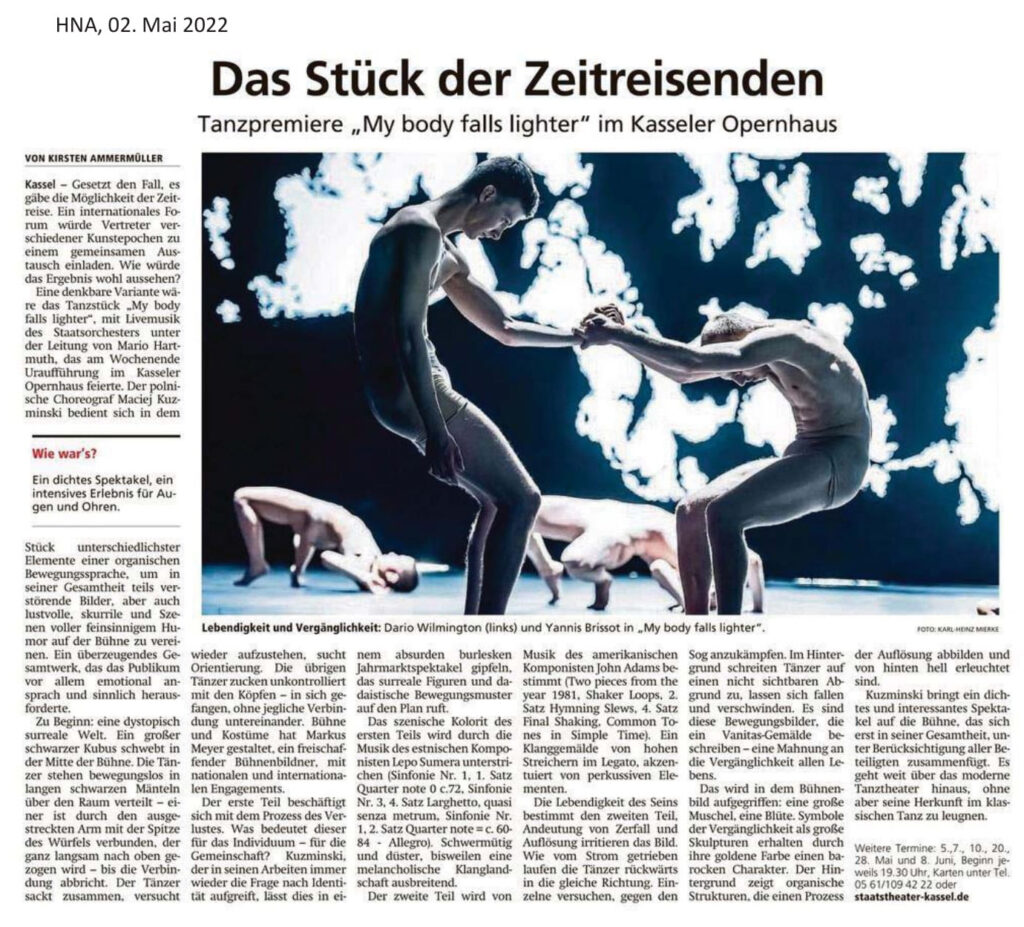
A great review after the premiere of my body falls lighter at Staatstheater Kassel. In an article titled “The play of the time travelers” Kirsten Ammermüller in Hessisch Niedersächsische Allgemeine writes
Kuźmiński uses the most diverse elements of an organic movement language (…) A convincing complete work that appealed to the audience above all emotionally and challenged their senses (…) goes far beyond modern dance theater.
Assuming there was the possibility of time travel. An international forum would invite representatives of different art epochs to a joint exchange. What would the result look like?
A conceivable variant would be the dance piece “My body falls lighter”, with live music by the State Orchestra conducted by Mario Hartmuth, which premiered at the Kassel Opera House at the weekend. In the piece, the Polish choreographer Maciej Kuźmiński uses the most diverse elements of an organic movement language in order to unite partly disturbing images as a whole, but also fun, bizarre scenes full of subtle humor on stage. A convincing complete work that appealed to the audience above all emotionally and challenged the senses.
At the beginning: a dystopian surreal world. A large black cube floats in the middle of the stage. The dancers stand motionless in long black cloaks spread across the room – one is connected by the outstretched arm to the top of the cube, which is slowly being pulled upwards – until the connection is broken. The dancer collapses, tries to get up again, seeks orientation. The rest of the dancers twitch their heads uncontrollably – trapped in themselves, without any connection to each other. The stage and costumes were designed by Markus Meyer, a freelance stage designer with national and international engagements.
The first part deals with the process of loss. What does this mean for the individual – for the community? Kuźmiński, who repeatedly takes up the question of identity in his works, culminates in an absurd, burlesque fairground spectacle that evokes surreal figures and Dadaist movement patterns.
The scenic coloring of the first part is underlined by the music of the Estonian composer Lepo Sumera. Mischievous and gloomy, at times unfolding a melancholic soundscape.
The second part is determined by music by the American composer John Adams. A sound painting of high strings in legato, accentuated by percussive elements.
The liveliness of being determines the second part, hints of decay and dissolution irritate the picture. As if driven by the current, the dancers run backwards in the same direction. Individuals try to fight against the pull. In the background, dancers walk towards an invisible abyss, let themselves fall and disappear. It is these movement images that describe a vanitas painting – a reminder of the transience of all life.
This is taken up in the stage design: a large shell, a flower. Symbols of transience as large sculptures are given a baroque character by their golden color. The background shows organic structures that depict a process of dissolution and are brightly lit from behind.
Kuzminski brings a dense and interesting spectacle to the stage, which only comes together in its entirety, taking into account all those involved. It goes far beyond modern dance theater without denying its origins in classical dance.

art, choreography, contemporary dance, dance, Germany, Hessisch Niedersächsische Allgemeine, HNA, Kassel, Kirsten Ammermüller, Maciej Kuźmiński, Markus Meyer, mybodyfallslighter, Silke Meier-Brösicke, Staatstheater, tanz_kassel, Theater, Thorsten Teubl

